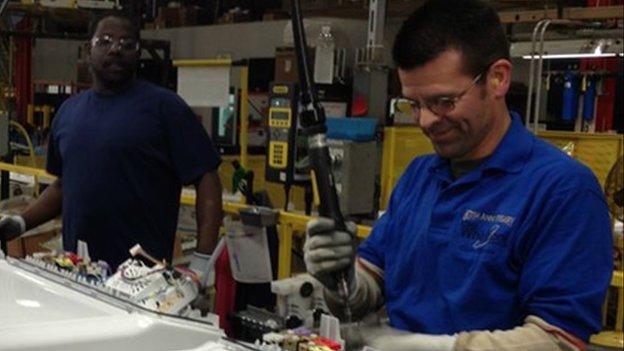Is 'Made in the USA' coming back?
- Published
- comments
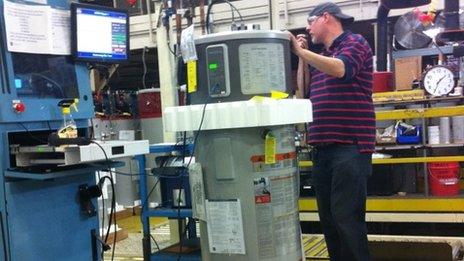
They are hiring, but new jobs at the Appliance Park plant pay much less per hour than the old ones
Dirk Bowman watches with pride as we walk along an assembly line, while workers tweak and twiddle with lines of cylindrical water heaters at this General Electric plant in Louisville, Kentucky.
"This is my dream come true," he says.
"It is really hard, but it is completely gratifying. Two years ago this place was full of cobwebs, old steel and no lights. Now we are actually making a product competitively."
Mr Bowman has worked at this plant for nearly 30 years, and he spent too much of that time closing down lines and laying off workers as their jobs were shipped overseas.
But now the heaters are home from China, fridge doors are back from Mexico, and after a $1bn (£655m) investment, the plant is making new products for the first time in 55 years.
Economics, not patriotism
Some think "outsourcing" has now been revealed as a passing fad. The new fashion is "insourcing". Perhaps it is more realistic to regard the change as part of a global rebalancing, as Asia becomes richer.
While Mr Bowman, who is in charge of manufacturing, is pleased and proud, he is quick to stress the return home is about economics, not patriotism.
"What drove this is competitiveness. We came back because we can make this product here for about a tenth of the labour we use in China.
"So we are more efficient, we waste less time, and then we redesigned it so it is a better product."
Appliance Park Loop in Louisville, Kentucky is bigger than many towns, and it epitomises what manufacturing used to mean in America.
There are six large factories amid other, smaller buildings. The car park is a mile long, with its own traffic lanes to manage the flow of shift workers back in the 1970s when it employed 23,000. It has its own power plant, rail lines and post code.
Appliance Park Loop churned out the dishwashers and washing machines that kept the American Dream sparkling clean and freshly laundered. There is a convincing argument that the solid, well-paid jobs at places like this drove the suburban, consumer-rich version of the dream that blossomed in the 1960s.
Workers earned enough to support a family and live a life that had once been the sole province of those who wore suits and ties to work.
But it didn't last.
New economic reality
One reason for the decline of manufacturing in the US was outsourcing - jobs shipped overseas. And it stung the American psyche.
I found out on the election trail last year that you cannot talk long about the economy with most Americans before someone moans about jobs going to China.
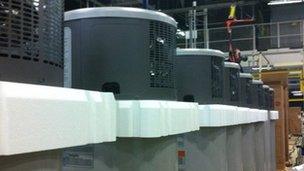
Behind the story of jobs returning to the States is a new global economic reality.
As wages went up in China, they went down at the GE plant. The company cut a deal with the union: while existing workers would still get up to $26 (£17) an hour, new ones would be paid only $14 an hour.
The discovery of huge reserves of shale gas and oil in North America keeps energy costs low in the US even as they rise in Asia.
And as I watch vast lorries exit the gates of Appliance Park it is obvious that transport costs are lower here, especially when the rising price of oil pushes up shipping costs.
Rich Calvaruso is in charge of devising new ways to keep costs down and quality up.
"It's the total cost of the product," he says.
"A lot of people just think about labour - that's what people thought about back in the '90s. But if you look at transportation, warranty costs, inventory, having all that stuff hanging around, it all adds cost."
"This is a relatively large product. If you make it thousands of miles away you have to ship here.
"We make this water heater and in four hours it is out the door. If it's made in China, it's like four weeks."
'A living, breathing thing'
Last year this plant doubled its workforce, hiring 6,000 more people.
And this isn't a one off - many other manufacturers are coming home.
President Barack Obama has set enormous store on the return of manufacturing.
"After shedding jobs for more than 10 years, our manufacturers have added about 500,000 jobs over the past three," he said in his State of the Union speech.
Barack Obama's tour, which began in North Carolina, follows his State of the Union address
"Caterpillar is bringing jobs back from Japan. Ford is bringing jobs back from Mexico. And this year, Apple will start making Macs in America again."
The next day he added: "I believe we attract new jobs to America by investing in new sources of energy and new infrastructure and the next generation of high-wage, high-tech American manufacturing."
But economist Julie Heath from Cincinnati University has a word of caution for those who believe the old days will return.
"Anytime you bring jobs back there is a positive effect on the American economy," she says. "The problem is they are a different kind of job. The jobs that are coming back are typically lower pay, sometimes lower benefits, than the jobs that were lost.
"Half the jobs lost in the recession were mid-pay jobs - jobs that could support a middle-class lifestyle. Since the recovery, of the 3.5 million jobs that have come back, only 2% are mid-pay jobs."
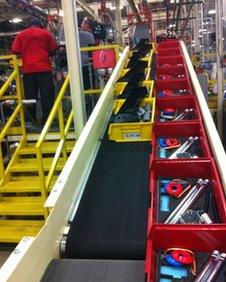
Manufacturing may never be as important to the American economy as it once was, but it is a badge and symbol - a sobering one for countries like the UK that have largely ditched their ability to make stuff.
Surrounded by the hum of machines and rows of heaters being packed in big brown cardboard boxes, Mr Calvaruso speaks eloquently about why manufacturing matters.
"This is awesome to me," he says.
"The real thing that makes this exciting is to see the operators and see the smiles on their faces and their involvement. They go to the store and they see their product: 'Look at this - I made that'.
"And they're proud of that. Because it is more than just putting stuff together, it's thinking with your body and your mind. It's a living, breathing thing."
- Published6 December 2012
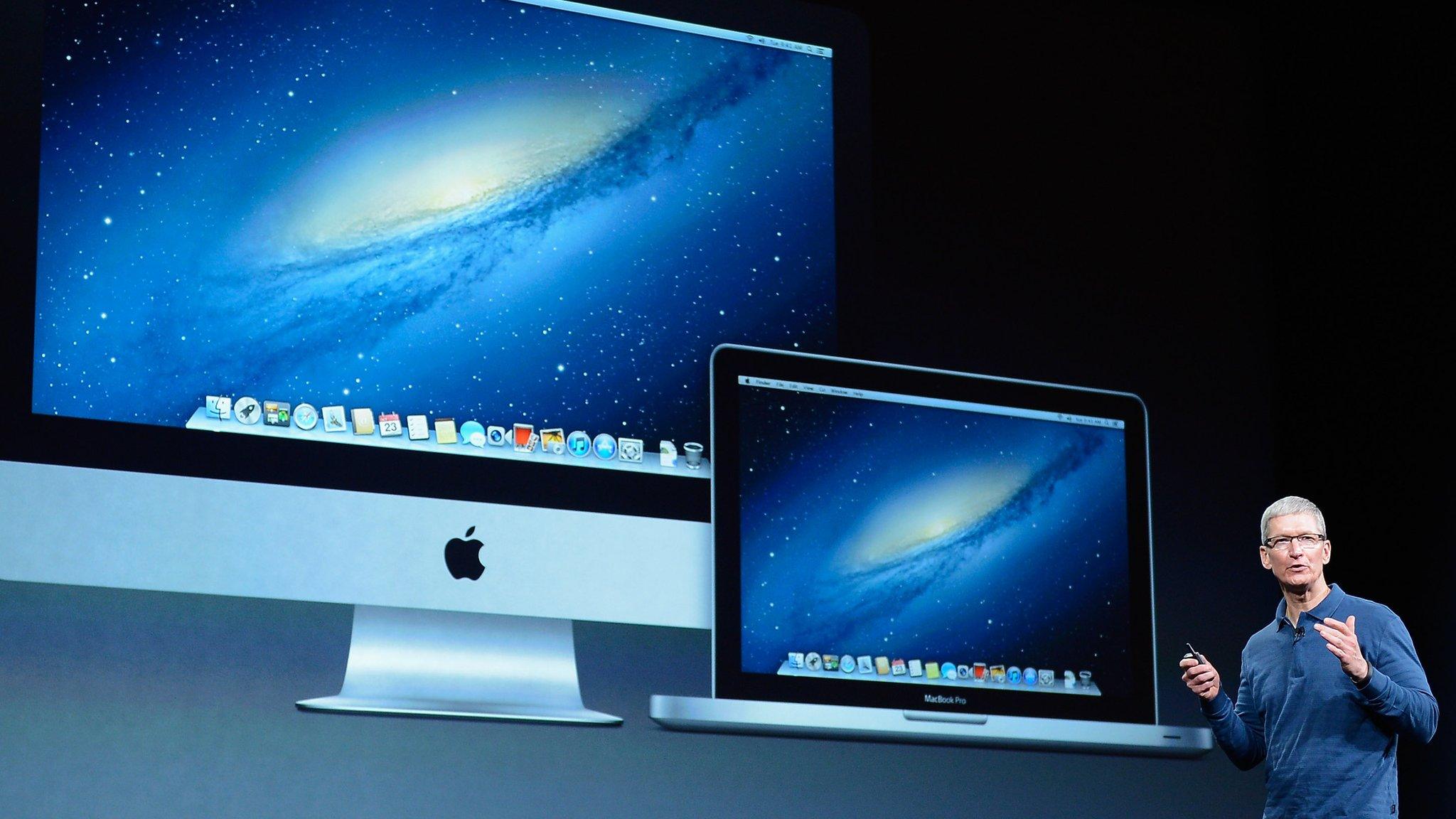
- Published23 January 2013
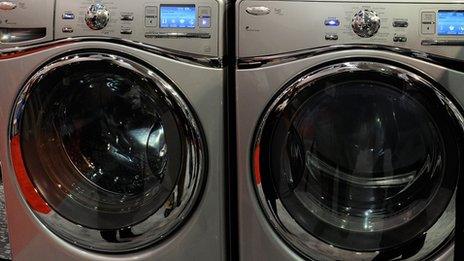
- Published16 January 2013
